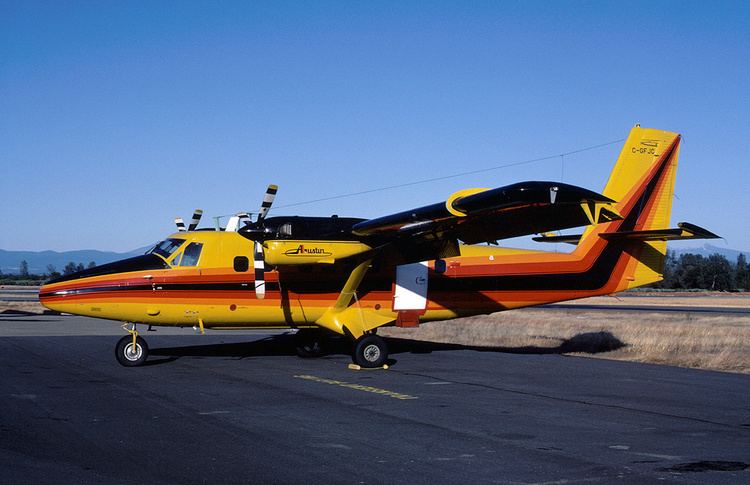Austin Airways was a passenger airline and freight carrier based in Timmins, Ontario, and the oldest in Canada.
ICAO Code:IATA Code: AAWCall Sign:It was Canada's oldest airline and started service in 1934. The home base was Timmins and it operated many duties in addition to passenger and freight services. Over the years, scheduled services served over 40 cities, including some destinations in the United States. In 1973 it merged with White River Air Services but continued to operate as Austin Airways.
In June 1987 it merged with Air Ontario Ltd (formerly Great Lakes Airlines (Canada), formed in 1958) to form Air Ontario Inc. In turn Air Ontario became part of Air Canada Jazz in 2001.
Over its long history, Austin Airways operated the following aircraft:
Beech 99 (turboprop)Cessna Citation (business jet)Consolidated PBY Canso (amphibian aircraft)de Havilland Canada DHC-2 Beaverde Havilland Canada DHC-3 Otterde Havilland Canada DHC-6 Twin Otter (STOL capable turboprop)Douglas DC-3 (includes C-47 model)Hawker Siddeley HS 748 (turboprop)Most of the locations Austin Airway flew were isolated and remote airports in Northern Ontario and a few larger airports across Ontario. Rupert House and Minneapolis were the only out of province locations flown by the airline by the 1980s.
Attawapiskat, OntarioBear Lake, OntarioBearskin Lake, OntarioBig Trout Lake, OntarioCochrane, OntarioFort Albany, OntarioFort Hope, OntarioFort Severn, Ontario - most northerly destinationGeraldton, OntarioKapuskasing, OntarioKasabonika Lake, OntarioKashechewan First Nation, OntarioKenora, OntarioLansdowne House, OntarioManitouwadge, OntarioMarathon, OntarioMinneapolis/St. Paul, Minnesota - only U.S. destinationMoosonee, OntarioNakina, OntarioPickle Lake, OntarioPikangikum, OntarioRed Lake, OntarioRound Lake, OntarioRupert House (Waskaganish, Quebec)Sachigo Lake, OntarioSandy Lake, OntarioSioux Lookout, OntarioThunder Bay, OntarioTimmins, Ontario - company headquartersToronto, OntarioWebequie First Nation, OntarioWinisk, OntarioWindsor, Ontario - most southerly destinationGreat Whale, QuebecSanikiluaq, NWTCape Dorset, NWTPovungnituk, QuebecIvujivik, QuebecSugluk, QuebecInukjuak, QuebecAkulivik, QuebecFort Rupert, QuebecEastmain, QuebecFort George, QuebecAccidents and incidents
In January 1964, Douglas C-47 CF-ILQ crashed 50 minutes after take-off on a cargo flight from Moosonee to Nemiscan Settlement, Ontario. Both pilots were seriously injured, but were pulled from the aircraft 4–5 days later by a search and rescue party and ultimately survived. It was determined that the crash was caused by fuel deprivation leading to engine failure of both of the aircraft's engines. To this day, the hulk of the aircraft still sits where it had crashed in 1964, despite being partially salvaged, and burned from a forest fire that swept across the area in the mid-1980s.On 9 November 1969, Douglas C-47B CF-AAL crashed on approach to Timmins Airport, Ontario killing two of the four people on board. The aircraft was operating a domestic flight from Winisk, Ontario.On 19 June 1970, Douglas C-47A CF-AAC was written off in an accident at Val-d'Or Airport, Quebec.On 10 December 1976, Douglas C-47A C-FIAX crashed on take-off from Chisabisi Airport. All eight people on board survived.On 19 January 1986, Douglas C-47A C-GNNA struck a 150 feet (46 m) high Non-directional beacon tower and crashed at Sachigo Lake Airport, Ontario. After clipping the top of the tower the pilot lost use of ailerons and plane began flipping over. He used the rudder to correct and spotted the runway making a controlled crash landing. The pilot saved all 5 on board with his actions but he himself suffered two crushed vertebrae. 
